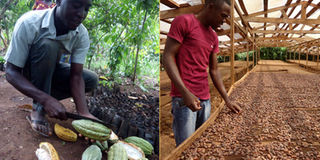Prime
Cocoa growing in Uganda

Splitting the pods to get the beans (L) and drying the beans (R). PHOTOS BY FRED MUZAALE.
Cocoa is a perennial crop that responds well in rainy tropical areas, with a maximum annual average of 30 - 32ºC. It thrives under shades and in areas with annual rainfall between 1,500mm to 2,000mm.
According to International Cocoa Organisation, it grows in countries lying between 10 degrees north and 10 degrees south of the equator. It does well in soil containing coarse particles with a reasonable quantity of soil nutrients to a depth of 1.5m to allow the development of a good root system.
Few farmers
Cocoa withstands water logging for a short time and since it is sensitive to inadequate water, it can easily dry up. During short dry periods, if not mulched or is planted in an open space where there are no trees to provide shades, it is also suspectible to drying. In Uganda, few farmers grow cocoa as most people think the crop is not economically viable. Uganda has an estimated 20,000 hectares of land under cocoa cultivation, mostly in the country’s west and central regions, and the crop supports about 10,000 households.
Taken interest
Dr Patrick Wetala, a cocoa researcher at Coffee Research Institute Kituza in Mukono District, says the organic cocoa is grown mostly in Bundibugyo, Mukono, Jinja, Kamuli, Buikwe, Masindi, Mayuge, Iganga and Kayunga districts on a small scale. It is estimated that only about 15,000 farmers are involved with cocoa in Uganda.
Some of the cocoa varieties grown on commercial scale include Upper Amazon, Trinitario and Amelanado. All these varieties are high yielding and have big beans. He says in areas where farmers have taken interest in growing the crop, their incomes have increased considerably, hence a better livelihood. “Cocoa cultivation was introduced in Uganda nearly 100 years ago, but its fortunes have fluctuated through the years as the government has concentrated on promoting coffee production, making the country Africa’s biggest exporter. Output peaked in the 1960s but subsequent government neglect, a lack of finance and price fluctuations throttled the sector in the 1970s and 1980s,” he says.
Profitable
Information from the Uganda Export Promotion Board (Uepb) shows that Uganda exported 17,935 tonnes of cocoa worth $44.5m in 2011. This was an improvement from the 14,529 tonnes worth $35m exported the previous year of 2010.
Currently, farm gate prices of fresh cocoa beans ranges from Shs2,000 to Shs2,500 while that of dry beans is at Shs6,000 depending on location and quality. Hamuza Asaba, coordinator, ICAM Chocolate Ltd, a company that supports farmers and buys cocoa in Buikwe, Mukono, Bundibugyo and Masindi, says that the crop is currently more profitable than coffee.
Biggest challenge
This is partly because of the high prices for cocoa beans and partly because a cocoa farmer earns money from the crop throughout the year. “Coffee has two harvesting seasons a year but with cocoa every time is harvesting season. It is only the amount of cocoa that goes up or down depending on the season,” he explains. However, he says the biggest challenge facing the farmers is the high incidence of pests and diseases that attack the crop. This, he says, calls for vigilance to fight them. Even though most of the cocoa grown in Uganda is exported, quantities of cocoa bean exported from the country are still small. This is while the demand on world market is high.
Increase production
A case in point, Asaba cites, is ICAM Uganda Ltd is supposed to export 5,000 tonnes of cocoa beans to ICAM Chocolate Italy Ltd but can only manage to export 2,000 tonnes annually. He says the company is trying to encourage more farmers to join the cocoa business through provision of free cocoa seedlings and offering seminars on how to grow the crop. He is confident that this would increase cocoa production in the country in the coming years.




